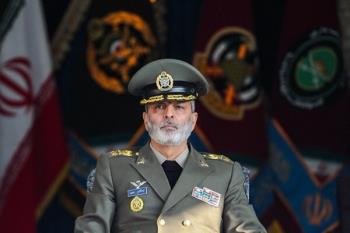Alwaght- The economic agreements signed with Russia under administration of late Iranian President Seyyed Ibrahim Raisi to upgrade trade relations with Moscow to a strategic level are coming to fruition one by one.
The banking network connection between Iran and Russia was one of the measures of martyr Raisi that these days is going operational, facilitating financial transactions between the two allies.
Mohsen Karimi, the deputy governor of central bank for international affairs on Tuesday referred to the comments of the governor of central bank of Iran on the monetary agreement with Russia and connection of Russian Mir payment system to its Iranian counterpart Shetab, saying that the agreement was part of a road map for de-dolarization and the joint actions taken by the two countries' central banks began to bear fruits at the end of President Raisi's government.
There were four important and strategic measures on the agenda of the central banks of the two countries, two of which were the brokerage relations with the national currencies and the banking payment infrastructures. Under these actions, all Iranian and Russian banks are now able to send standard banking messages. To take advantage of these two strategic infrastructures, two other measures were necessary; one signing a monetary agreement between the two countries and the second was providing card payment services for their citizens in the two countries.
Karimi added that these two infrastructures are finalized and will go operational in the coming weeks. In other words, Iranian and Russian travelers can use their bank cards in ATMs and POSs in both countries. He added that the monetary deal signed between the two central banks is a liquidity exchange line between the two countries, which is an approach to de-dollarize and mitigate sanctions impacts.
Iran-Russia banking and monetary network integration was part of the framework of bilateral agreements that are supposed to accelerate the banking transactions. According to experts, this move will also greatly help to strengthen the tourism industry of both countries, and Russian and Iranian citizens will not have a problem paying and getting the currency they need.
Iranian-Russian trade jump
Although Iran and Russia had relatively good economic relations for a long time, these relations reached their highest point under administration of late President Raisi.
Under Raisi, Iran became a member of the Eurasian Economic Union (EAEU) which, according to experts, will increase trade relations between Iran and other members of this trade bloc. We can see its effects in the volume of Iranian trade with the union.
Iran and Russia in July 2022 signed a $40 billion deal which will see Russia investing in Iranian oil sector. The two allies also signed a 20-year comprehensive cooperation pact according to which Tehran-Moscow cooperation will level up. Its effects are already observable in their bilateral business.
Referring to the strengthening of economic cooperation between Iran and Russia, the Deputy Foreign Minister for Economic Diplomacy Mahdi Safari said that at the beginning of the government of Sayyed Ibrahim Raisi, the volume of trade between the two countries was $1.2 billion per year, but in 2023, it increased to about $5.3 billion.
In 2023, Safari added, the Iranian agricultural exports to Russia were in a good condition. "We had $3.2 billion exports to Russia and imported worth of $2.1 goods from this country. We also signed contracts for the export of cars to Russia, and good things have happened in the export of knowledge-based products and petrochemical products, including catalysts... In 2024, we plan to export 15,000 cars to Russia. Joint projects have also been defined in the field of shipping and cooperation in BRICS. Openings have also been made in the customs sector."
Commenting on the recent changes to the Iranian export basket to Russia, Iranian ambassador to Russia Kazem Jalali said that a major portion of the trade of the two countries in the past was corps, but now we witness exports of various tech products. The ambassador pointed to their cooperation in turbines, medical facilities, hygienic products, chocolate, pantry, bags, shoes, leather, clothing, and furniture, saying that "today, some Iranian products, including sweets and chocolates and health products can be seen on the shelves of Russian stores and have opened their place well in this country.
Neutralizing Western sanctions
Countering American unilateralism is the most important common agenda of the two countries, and given the Western sanctions on them, Tehran and Moscow are trying to put aside the US dollar to facilitate transactions with national currencies. Taking advantage of dominance of the dollar in global trade, the US for decades created serious problems for countries that are not aligned with the West. However, by de-dolarization, Iran and Russia can reduce the effects of sanctions on bilateral relations.
On the other hand, due to its geopolitical position, huge oil and gas reserves, military power and economic potentials, as well as regional influence, Iran will play a central role in regional trade. With Iran's membership in international organizations such as China and Russia-led Shanghai Cooperation Organization (SCO) and BRICS, Tehran has strengthened its Eastern partnerships.
In terms of expanding trade ties between the two countries, North-South Corridor is of special significance. With European borders closed to Russia, Moscow specially counts on the Iranian railway network to maintain its foreign trade arteries, and the North-South Corridor launch was to this end. This transportation corridor is cost-effective for Russia, because this country would have to use several sea and rail routes to transport its goods to the Indian Ocean and the Persian Gulf, and with the opening of this project, Moscow will save money in its trade.
Iran and Russia more than any other countries have figured out the importance of railway and maritime routes in the future global trade and are trying to expand their transportation infrastructures to play an important role in the global trade. The fact that the American officials voice their concern about launching corridors between Iran and Russia, which is done with the aim of circumventing the sanctions, shows that Tehran and Moscow have been able to make the sanctions less effective with new initiatives. Meanwhile, the efforts of regional countries to boost business and political ties with Tehran and Moscow indicate that Washington’s push to isolate these two countries has met its failure.
Having in mind that railways are more difficult to track than maritime routes, with completion of their railway networks, the Western sanctions will lose their effects in the future and Washington will lose this pressure lever to align non-compliant countries to its policies. The broader transit corridors of the two countries expand, the more business ties of the two countries will be facilitated.
After the Ukraine crisis, Russia and its allies in the East have tried to bolster their alliance against the Western camp. Strengthening regional economic organizations and creating new corridors are part of this strategy, which has been largely successful.
Prospects of Iran-Russia business ties
Tehran and Moscow have upgraded their ties in all areas to strategic levels, and the frequent meetings of their senior officials are meant to boost their bilateral bonds.
Although their economic relations are not at acceptable levels, the designed plans are expected to push them up to their highest levels in the future. Commenting on the time of realization of trade plans with Russia, Iran's Oil Minister Ali Owji said that "in the next 1.5 year, we are expected to reach $40 billion in business ties with Russia." Therefore, the greater the trade relations between the two countries and the more the dollar is removed from bilateral trade, the greater openings will be available in the field of the domestic economy. Absence of interbank interaction was one of the serious problems between the two countries, and with the implementation of the joint banking network, Russian and Iranian investors will be encouraged to invest in infrastructure and various economic sectors.
The global developments after Ukraine war have motivated Iran and Russia to further convergence, and now the relationship between the two allies is so strong that even the belligerent US actions cannot damage them. Dominating regional railway and maritime routes, Russia and Iran prepare themselves to play a significant role in the new world order, a multipolar order in which East will be leading and China-Russia-Iran triangle will be at the center.



























